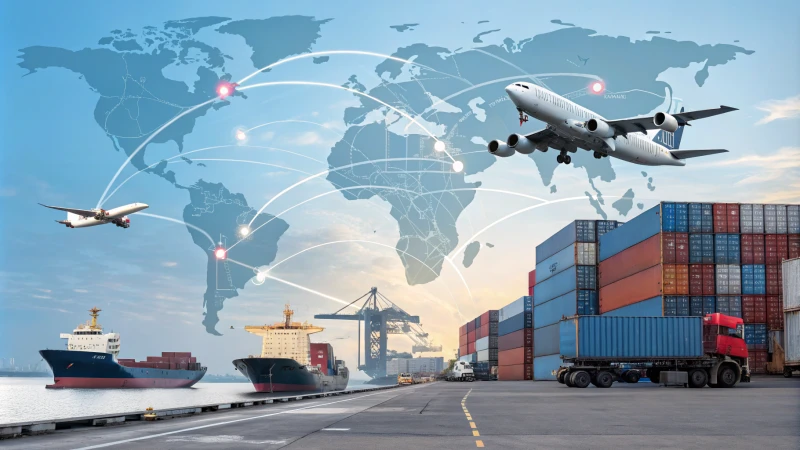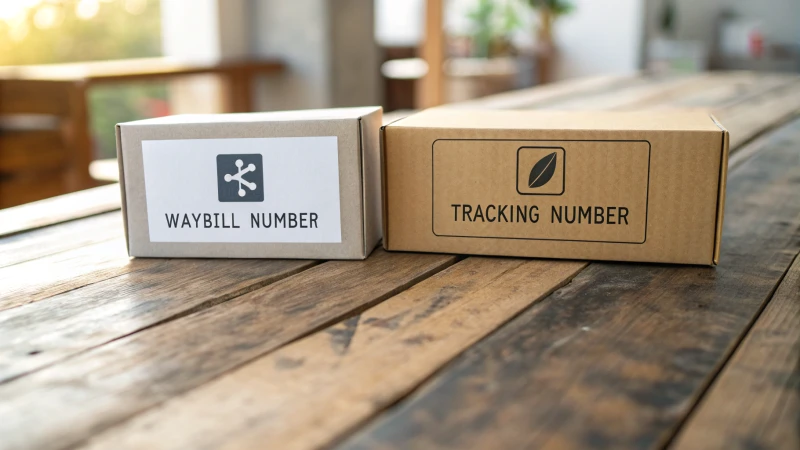Ever been stumped by the difference between a waybill number and a tracking number? You're not alone!
A waybill number is typically used in air freight and larger shipments, while a tracking number is commonly associated with parcel delivery services. Both serve as unique identifiers for tracking shipments, but their usage varies depending on the carrier and context.
I remember the first time I shipped a large order from my business, I was completely baffled by the shipping jargon. The terms 'waybill' and 'tracking number' seemed interchangeable at first, but I quickly learned they have distinct roles. Understanding this helped me better manage my imports and ensured smooth deliveries. Let’s explore how these identifiers function across different carriers and shipment types, ensuring your goods always arrive on time.
Waybill numbers are only used in air freight.False
Waybill numbers are used in various transport modes, not just air freight.
Tracking numbers and waybill numbers are unique identifiers.True
Both serve as unique identifiers for tracking shipments.
What Are the Key Differences Between Waybill and Tracking Numbers?
I remember the first time I had to figure out logistics for my business; the terms "waybill number" and "tracking number" were like a secret code I needed to crack. Understanding these can really make a difference in how smoothly your shipments go.
Waybill numbers are mostly used in international or air freight shipments, whereas tracking numbers are common in parcel delivery services. Both are crucial for tracking but cater to different logistics needs.
Understanding Waybill Numbers
When I first started dealing with international shipments, waybill numbers became my go-to tool for keeping things organized. They’re essential in air freight and large-scale logistics operations. These numbers often form a part of the Airway Bill1, providing comprehensive details about the shipment, from sender and receiver information to package contents. It felt like having a detailed passport for each of my shipments.
| Feature | Waybill Number |
|---|---|
| Usage | Air freight |
| Documentation Type | Airway Bill |
| Details Provided | Comprehensive |
Exploring Tracking Numbers
I bet you’ve seen tracking numbers countless times, especially if you’re like me and order parcels regularly. These are more consumer-friendly, frequently used in parcel delivery services. They allow me to monitor the status of my shipment in real-time, although they might not offer detailed shipment information like waybill numbers.
| Feature | Tracking Number |
|---|---|
| Usage | Parcel delivery |
| Documentation Type | Simple tracking |
| Details Provided | Limited |
Practical Implications in Logistics
Grasping these differences has helped me streamline my logistics processes, particularly for my wholesale electronics business. For international shipments, using a waybill number ensures that every detail accompanies the goods. In contrast, tracking numbers are perfect for smaller, domestic shipments where I just need real-time updates.
Choosing Between Waybill and Tracking Numbers
Choosing between these numbers often boils down to the shipment's scale and destination. For instance, a waybill number is indispensable in freight forwarding2 when dealing with multiple carriers across countries. However, for local deliveries where speed and simplicity are crucial, a tracking number does the trick.
By distinguishing these terms, I've been able to communicate effectively with carriers, ensuring smoother operations across different shipping methods3. This knowledge has made me more confident in managing my shipping needs efficiently.
Waybill numbers are used in air freight logistics.True
Waybill numbers are part of the Airway Bill used in air freight.
Tracking numbers provide comprehensive shipment details.False
Tracking numbers offer limited details, mainly for real-time updates.
How Do Different Carriers Use Waybill and Tracking Numbers?
Ever been curious about how your packages seem to magically find their way to your doorstep?
Waybill and tracking numbers are essential tools in the logistics world, helping carriers monitor shipments. They serve different purposes—waybills often handle larger or international shipments, while tracking numbers offer real-time updates, ensuring everything arrives on time.

Understanding Waybill Numbers
I remember the first time I had to manage a major shipment from China. The anxiety of ensuring everything was in order was overwhelming. That's when I learned about waybill numbers—these are the backbone of air freight4 and logistics. They provide all the crucial details like sender and recipient information, and even what's inside the package. When you're dealing with larger or international shipments, waybills are your best friend in navigating compliance with shipping regulations.
| Carrier | Waybill Number Format |
|---|---|
| DHL | 10-12 digits |
| FedEx | 12-14 digits |
Role of Tracking Numbers
On the other hand, tracking numbers became my go-to when handling smaller shipments. Like when I was sending out a batch of electronics to a retailer across the country. With tracking numbers, I could see where each package was at any given moment. This is crucial for making sure everything stays on schedule, especially when dealing with small to medium-sized shipments.
- USPS: Often includes letters and numbers.
- UPS: Generally an 18-character alphanumeric code.
Comparing Waybill and Tracking Numbers
Now, you might wonder how these two compare. In my experience, a waybill5 is packed with comprehensive shipment information—routing details, special handling instructions, you name it. But when it comes to real-time updates, tracking numbers are the way to go.
Carrier-Specific Practices
I've noticed that different carriers have their unique ways of using these identifiers:
- DHL: They smartly combine waybill and tracking functionalities for seamless international deliveries.
- FedEx: They keep things separate, using waybills for compliance and tracking numbers for delivery updates.
For more insights, you can explore carrier practices6 to understand these differences in depth.
Understanding the nuances between waybill and tracking numbers has been a game-changer for my shipping operations. Especially in the world of international logistics7, knowing how each carrier operates allows me to optimize my strategies and ensure everything arrives on time.
DHL uses 10-12 digit waybill numbers.True
DHL's waybill numbers are formatted with 10-12 digits for shipments.
UPS tracking numbers are only numeric.False
UPS tracking numbers are alphanumeric, typically 18 characters long.
Why Should I Care About Numbers in Logistics?
Ever wonder how logistics numbers can transform a business? They’re the secret sauce behind efficient operations and strategic success. Let's dive in!
Understanding numbers in logistics is crucial for optimizing operations, predicting demand, and making informed decisions. KPIs like delivery time and cost per shipment are essential for guiding strategic decisions and enhancing supply chain efficiency.

Key Performance Indicators (KPIs) in Logistics
I remember the first time I really delved into logistics KPIs—it felt like uncovering a hidden code that could unlock incredible efficiencies. These metrics, such as delivery accuracy and lead time, are like a report card for our processes. They help me pinpoint what's working and what needs tweaking. By keeping an eye on KPIs8, I can track our progress and make sure we're moving in the right direction.
| KPI | Definition |
|---|---|
| Delivery Accuracy | Percentage of orders delivered accurately |
| Lead Time | Time taken from order to delivery completion |
Demand Forecasting
Demand forecasting was a game-changer for me. There was a time when I overstocked and ended up with inventory gathering dust in the warehouse. Now, by analyzing past sales data and spotting trends, I can predict what my customers will need and when. This insight means we keep just the right amount of stock, cut down on storage costs, and keep our customers happy by meeting their needs promptly.
Using forecasting tools9, I can anticipate changes in demand, allowing me to adjust my supply chain strategies efficiently.
Cost Analysis and Reduction
I once thought I had a handle on costs—until I really started analyzing logistical numbers. Understanding the cost per shipment opened my eyes to potential savings. For example, I discovered more economical shipping routes and learned to negotiate better rates with carriers. Regularly reviewing these financial metrics means I make decisions that boost profitability without compromising on service quality.
By regularly reviewing financial metrics, businesses can make informed decisions that enhance profitability while maintaining service quality.
Enhancing Decision-Making
Data-driven decision-making is my go-to strategy now. By truly understanding logistical data, I can respond quickly to market changes and optimize resource allocation. This approach enhances our supply chain efficiency immensely.
Integrating business intelligence10 tools into our logistics operations gives us real-time insights and predictive analytics. This strategic use of data has transformed how we operate, giving us a competitive edge in this dynamic market environment.
KPIs in logistics only measure financial performance.False
KPIs also evaluate operational efficiency, like delivery accuracy and lead time.
Demand forecasting helps reduce storage costs.True
Predicting demand optimizes inventory levels, preventing overstocking and reducing costs.
Conclusion
Waybill numbers and tracking numbers are unique identifiers for shipments, with waybills used in air freight and larger shipments, while tracking numbers are common in parcel delivery services.
-
Learn how Airway Bills are crucial for air freight, detailing shipment specifics necessary for international transport. ↩
-
Discover the role of freight forwarding in simplifying complex shipping processes involving multiple carriers. ↩
-
Understand various shipping methods to choose the best fit for your business logistics needs. ↩
-
Learn about air freight's role in logistics to understand why waybill numbers are crucial in this context. ↩
-
Discover the significance of waybill numbers in global shipping processes. ↩
-
Explore carrier-specific practices to see how they manage these identifiers. ↩
-
Understand international logistics to see how tracking and waybills play a role in cross-border shipping. ↩
-
Discover how KPIs serve as benchmarks for evaluating logistical performance and guiding strategic improvements. ↩
-
Explore top forecasting tools that help businesses predict demand and optimize inventory management. ↩
-
Understand how business intelligence tools provide real-time insights to enhance logistics operations. ↩




